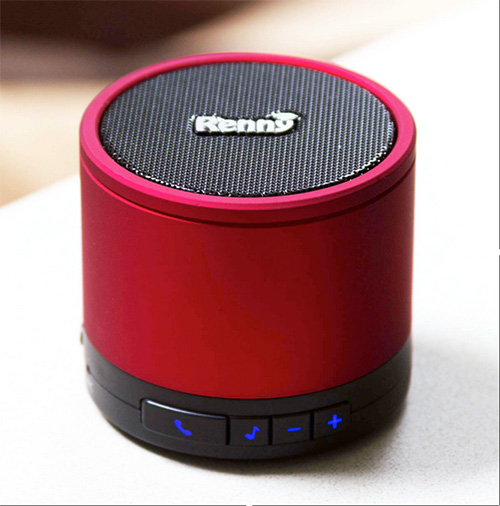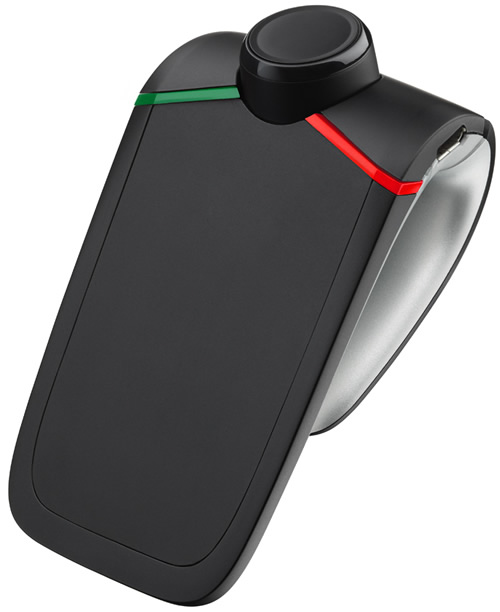|
|
||||
Renny offers selectable ring tones (most of which – as with most such devices – suck) and the company says streaming music to the device is enhanced by its "powerful loudspeaker using 3D Digital Dynamic Bass technology." The sound is fine in a pinch but, as mentioned above, if you're looking for a wireless speaker that rocks, this isn't the one.
A nice touch is that Renny's "DualSync" technology lets you connect two mobile phones at once.
The Renny is always on (if it's charged) and just sits there relatively unobtrusively, waiting patiently for a call to come in, at which time it leaps to action. It's available in black, blue, white and – as was the case with the demo unit – a nice, deep crimson color.
When a call comes in, you just have to tap the button on Renny's side to answer it, then speak as you would with any speaker phone. Voice quality is reasonable.
The Renny could also come in handy for people who don't have a land line, an increasingly growing group these days. It goes a long way toward offering the kind of multi-room expandability you can get from the multiple handsets popular with wireless land line phones.
Polly wants a crackerjack hands free car unit…
There are many sun visor-mounted Bluetooth phone adapters on the market, but the $100 Parrot Minikit Neo offers some features designed to set itself apart from the pack. One of the niftiest is the fact that it'll turn itself on automatically when you enter your vehicle. The thing actually senses the vibration of your buttocks hitting the seat (undoubtedly as task of varying difficulty), and greets you with a little wakeup noise. And you can set it to greet you with whatever sound you choose, using an app you can download and install.
It's a sophisticated unit that's easy to pair and, like the Renny, will work with two cell phones. It also syncs with your address book and will stream audio from your smart phone – though (unlike some of the competition) it doesn't offer an FM modulator to pass the audio to your car audio system. That, depending on your wont, could be a deal breaker.

The sound quality from phone calls is fine, but the quality of the built in robotic voice isn't as good, so you'll have to listen carefully to what it's telling you. That may be part of a learning curve that gets less important the longer you use the unit, however.
"Magic" voice commands let you fire up the unit without touching its rather hard to push buttons, and the operation itself is child's play. There are really only three controls other than the basic on/off switch: the green "initiate call" button, the red "hang up" button and a rotary knob/button you can use to scroll through your contacts or the onboard menus that let you adjust a variety of the Parrot's parameters.
Parrot says you can get up to six months on a charge (charging, they say, takes up to three hours) and you can get it to tell you how much charge is left by asking it. If only kids were as cooperative!
The free app you can download and install (Android or Apple) not only lets you change the greeting sound, it also offers a full suite of other things, including a "find my car" feature that works with your navigation app (it remembers its location automatically), a parking timer to save you from tickets, an auto reply SMS feature that fires off a message to your caller if you're driving and don't want to answer, and more.
The Minikit Neo's sun visor clip is built right into the unit and isn't adjustable, and this could cause some angst among some potential owners. It should work with most vehicles, but it wouldn't clip onto the weirdly-shaped sun visors of the current Mazda MX-5 (nee Miata) and there are undoubtedly other vehicles that will cause it similar issues.
As far as its hands free phone performance is concerned, however, the Parrot Minikit Neo works very well. Its voice recognition is good – better than expected; don't overthink it and try to pronounce words more clearly that you would normally or it might get confused, though. But if you speak in a normal voice (if you have a thick accent it could cause problems, however) it picks up your words well.
Bluetooth hands free phone operation should really be installed in every new car today, as a safety feature, because it lets you keep your hands on the steering wheel. But for cars that don't come with it, and older vehicles, the Parrot and its ilk effectively retrofit the vehicle to take advantage of Bluetooth – as long as your phone offers Bluetooth capability as well.
And unlike the Bluetooth systems built into vehicles, you can take the Minikit Neo on the road with you, turning your rental cars into hands free units as well.
Just don't forget it's there and leave it in the car when you take it back!
Copyright 2013 Jim Bray
TechnoFile.com
Jim Bray's columns are available through the TechnoFile Syndicate.
 Parrot, Renny devices help avoid missed calls at home and away
Parrot, Renny devices help avoid missed calls at home and away